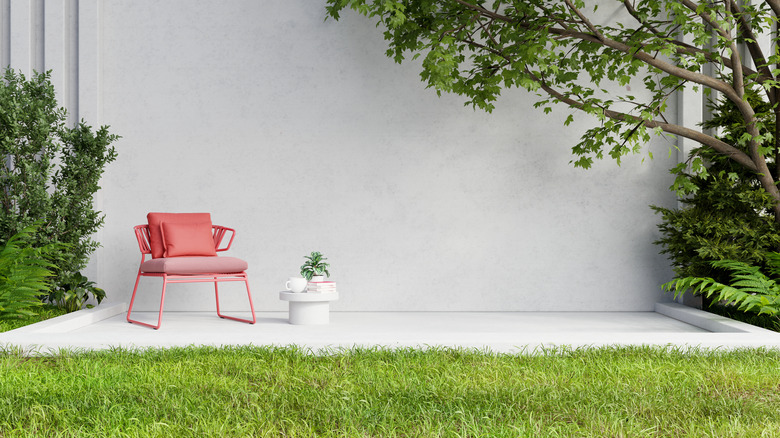How To Install Stone Or Brick Over An Existing Concrete Patio
We may receive a commission on purchases made from links.
Covering that dingy, old concrete patio with brick or concrete pavers is a great way to revitalize it, and there are two ways to do it. The most common way is to set the new pavers in sand, but it's also possible to affix them to the concrete with mortar. The sand-set method is easier, and it's preferable if the concrete is old and cracking because widening cracks are more likely to damage the pavers if they are physically attached to the concrete.
You need to evaluate the condition of the concrete pad before you start, and you should also make sure it slopes to allow water to drain off. A minimum slope of 2 percent is recommended, which is a little more than 2 inches of vertical drop for every 100 inches (about 8 feet) of horizontal distance. Also be aware that you'll be raising the height of the patio surface by several inches, which may require modifications to door thresholds and transitions from the patio to other surfaces.
Evaluate the Patio Condition and Set a Border
Evaluate the Patio Condition and Set a Border
A few small chips and spalls in the concrete won't matter, and even small cracks are allowable provided they aren't spreading. If you see one or more large cracks that have been growing over the years, though, that's a problem. They probably mean the patio has been heaving as the subsoil contracts and expands with the seasons, and the continued movement will likely damage the pavers.
Once you've determined the patio is in good enough condition for pavers, scrub it thoroughly with soap and water. You'll need to set a border if you're using the sand-set method, and while this isn't as crucial when using the mortar-set method, it's recommended for stability and appearance.
When using the sand-set method, the border pavers should be 3/4 inch thicker than the field pavers to allow for a bed of sand under the field, but the border can be the same thickness as the pavers when using the mortar-set method. Glue the border pavers to the perimeter of the concrete pad using an elastomer adhesive or if you're using the mortar method, set them in 1/2 inch of mortar fortified with a latex additive for flexibility.
Set the Field Pavers
Set the Field Pavers
When using the sand-set method, start by covering the concrete with landscape fabric to prevent sand from falling through small cracks in the concrete and then shovel paver sand on top of it, screed the sand level, and tamp it down. You want a flat, level surface that brings the field pavers to exactly the same level as the border. To determine how many cubic feet of sand you need, multiply the area of the patio by the difference in thickness between the pavers and the border. For a 10 x 10-foot patio, you need 75 cubic feet of sand if this difference is 3/4 inch.
Once you've created the sand substrate, set the pavers with about a 1/2-inch gap between them, tapping each one lightly with a rubber mallet to seat it. When using the mortar method, you don't need a layer of sand. Just butter the underside of each paver with 1/2 inch of mortar, set it in place, and tap it lightly to seat it.
Filling the Gaps Between Pavers
Filling the Gaps Between Pavers
If you're setting the pavers with mortar, you can fill the joints between pavers with mortar as you set them. When setting each paver, spread about 1/2 inch of mortar on each exposed side prior to setting the pavers that go next to it. When the mortar sets, you have to go back and clean the joints with a brush or a striking tool to remove excess mortar.
When using the sand-set method, you don't necessarily have to fill gaps between the pavers if they fit tightly together, but in most cases, you'll want a filler for a more uniform appearance. Use polymeric filler sand, which is finer than the sand you used for the base. Pour it liberally over the patio and use a push broom to sweep it into the gaps. Blow away any excess with a leaf blower and then wet down the patio with a garden hose to compress the sand.
